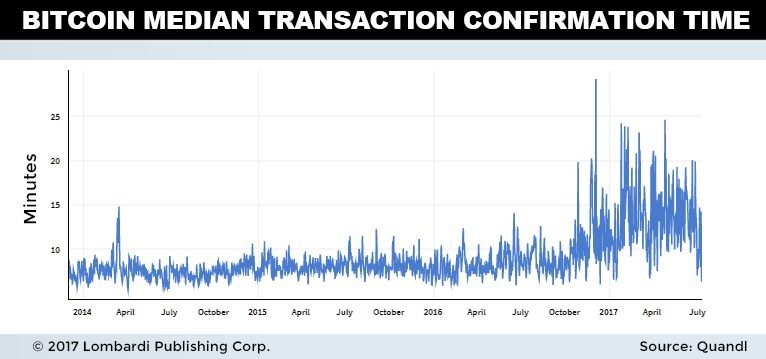Ethereum vs. Bitcoin: Which Is The Better Second Half 2017 Investment?
Ethereum vs. Bitcoin. It’s amazing we’re even pondering the question about which cryptocurrency will see the better 2H 2017 returns. At the end of 2016, Ethereum’s currency token ether (ETH) was trading around $8.00/ETH, near the bottom of a range which peaked over $15.00/ETH. Meanwhile, Bitcoin (BTC) was trading in the ballpark of 100 times ether’s price, on the cusp of a new major up leg. Both were in two different leagues. But Ethereum has since exploded onto the scene in 2017, vying with Bitcoin for crypto supremacy. Which becomes the better 2H 2017 investment will depend less on sentiment this time around, and more on technical inner workings which make both cryptocurrencies tick.
Specifically, the “inner workings” in which I speak of involve the much-anticipated result of Bitcoin’s core software upgrade on August 1, 2017. This is the so-called “user activated soft-fork” (UASF) deadline, which is fast approaching. The reasons for the upgrade trace back to Bitcoin’s origins. At the beginning, daily average Bitcoin transactions totaled in the hundreds, then the thousands. At previous rates, Bitcoin’s 1MB maximum block size could reasonably handle the volume of transactions is a respectable amount of time (although this was still measured in minutes, as opposed to the seconds most retail consumers are accustomed to).
But as popularity exploded, so have transaction processing times and fees. By mid-2017, daily average Bitcoin transactions total around 350,000 and payment confirmation times are becoming untenable. On April 24, 2017, they surpassed 24 minutes, and it’s not uncommon for confirmations to take over an hour. This is an eternity in the retail world and puts Bitcoin at a distinct disadvantage against traditional payment systems. Transaction overflow has also resulted in much higher fees as users compete every 10 minutes for limited space in the block. The cost benefit advantage Bitcoin used to carry has largely evaporated.
These types of challenges for new industries are nothing new. All industries must go through evolutionary adjustments early in their life cycle to adapt to shifts in consumer demand. But due to the decentralized nature of the community, instituting changes is proving difficult. Bitcoin does not conform to a traditional management hierarchy, making decisions from the top-down. Without a clear consensus, instituting any new changes is a long, drawn out slog. We see this at play today, even when the community recognize changes are needed.
In October 2016, a team of developers selected at a Hong Kong meeting released something called the “SegWit” code. SegWit was suppose to help Bitcoin’s scalability problem by storing signatures separately from transaction data, thus freeing up block space. It also enhanced some important security features. However, activation requires 95% of nodes to signal their support. To date, this has not happened. The reasons behind the lack of support are beyond the scope of this writing. But needless to say, the stakes couldn’t be higher. (Source: “Why Bitcoin’s value could get even more volatile,” Venture Beat, July 8, 2017)
Why? Competing interests between core developers and miners are threatening to fracture Bitcoin into two currencies. Both of these groups have competing visions and interests they are trying to protect. This is what’s known as a “hard fork.” If this happens, it could do irreparable damage to the “brand.” Much in the same way as if the Federal Reserve couldn’t decide on what grounds to issue currency, subsequently splitting the U.S. dollar into “two”. Bitcoin, as a currency, would look less unified and a hard fork would cast doubt on the community’s future ability to come together to make Bitcoin stronger.
It is largely the problem of scaling ad soaring costs caused by transaction overflow Bitcoin developers and miners seek to resolve. The problem is, different factions within the Bitcoin community can’t agree. If enough miners decline to meet the demands of soft fork supporters, the software upgrade could fail.
That August 1, 2017 outcome will largely dictate whether ethereum vs, bitcoin investment dollars flow towards the former or the later. It will also set the tone for the remaining of the half once the dust settles.
Ethereum vs. Bitcoin – Where to Invest in the Next Six Months
Again, this largely depends on Bitcoin’s software implementation at the UASF deadline. A full SegWit acceptance will go along way to allaying fears about a hard fork, promoting stability and confidence in Bitcoin. It may even be the basis for a new up-leg in price, now that the “sell first, ask questions later” crowd has left the building. But then again, it’s possible that the hard fork issue is entirely overdone.
Case in point: Ethereum has gone through four hard forks with no lasting ill effects. In fact, their community seems to embrace hard forks as a necessary way to fine tune the code and fix technical problems. It’s entirely possible life may chug along as usual, even with Bitcoin owners owing two iterations of the coin. This wouldn’t be dissimilar from what took place in July 2016 with Ethereum, which split into two separate tokens after a hard fork took place. While ETH became the standard, Ether Classic trades at a respectable $20/token. Needless to say, the split in token didn’t prevent ETH from soaring to nosebleed heights.
In our mid-May bitcoin forecast, we erred on the cautious side. We were big believers in the “coming of age” for Bitcoin, but it has happened even earlier than expected. The 80% upside we predicted may end up being conservative, but the year’s not over. Bitcoin has already touched $3,000/BTC in June 2017, but has since pulled back into consolidation mode. Some of this pullback is likely related to the hard fork concerns discussed here.
But we’re revising our upper-end bitcoin price prediction 2017 to $3,800/BTC ($2,800 median price), provided the SegWit implementation occurs without issue (including the proposed increase in block size from 1MB to 2MB). This may not solve all of Bitcoin’s scalability and processing times issues, but it will buy time for the community to implement something better. But most importantly, smooth SegWit will harmonize the community, ease some sell-side pressure and ensure Bitcoin’s reputation as the King of digital gold.
Our ethereum forecast is somewhat more complicated mainly for how far it’s come. It rose 50-fold from $8/ETH at 2016’s end to $400/ETH is June 2017. Obviously, a multi-month period of consolidation and range testing is in the cards.
While we remain staunch bulls of Ethereum’s eventual impact in the marketplace (mainly in the way of smart contracts), it does not have the reach in payment usage of Bitcoin. Mass adoption of ETH as a transacting currency will likely be more measured. And there’s much more overhead supply than Bitcoin (93.24-million vs. 16.44-million tokens). Thus, it’s possible ETH might muddle along here while demand catches up with price.
Considering these and other variables, our ethereum price prediction 2017 is between $224-$336/ETH, trading between a 0.08-0.12 ratio to Bitcoin ($2,800 median price). This is an upgrade of the end-of-year $150/ETH target we predicted last month. This newfound “optimism” has less to do with ETH breaking out by 2017 year’s end (although it’s certainly possible) as it does with the cryptocurrency class being propelled by further Bitcoin advances.
As of this writing, ETH is trading at $225/BTC at a 0.935 ratio to Bitcoin.
Beyond 2017, anything can happen. Even industry experts cannot accurately predict how lightening-fast cryptocurrency growth will play out. Much will depend on whether sovereign nations take the Japanese route and recognize them as legitimate currencies, or the German route and openly display hawkish intentions. We can all agree that the technology is valuable and here to stay. The million dollar question surrounds adoption. Will regulators around the world embrace all the blockchain currencies as fiat equals, or will they treat them as hostile enemies to their monopoly-based fiat systems.
Time will tell.



Nice blog. Really appreciate you bring this to our attention. Buy and hold for the upcoming 2 to 5 years and the market will find it's way. We do need to look better at the insights of every coin. What team is behind it, is there any management. How strong is the product, is there any product at all? I really advice people to take a look at: https://www.coincheckup.com Supposingly they researched every crypto coin in the scene based on: the team, the product, advisors, community, the business and the business model. They even score the coins stengths. Check: https://www.coincheckup.com/coins/Ethereum#analysis For the Ethereum Investment research report.